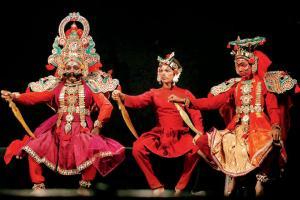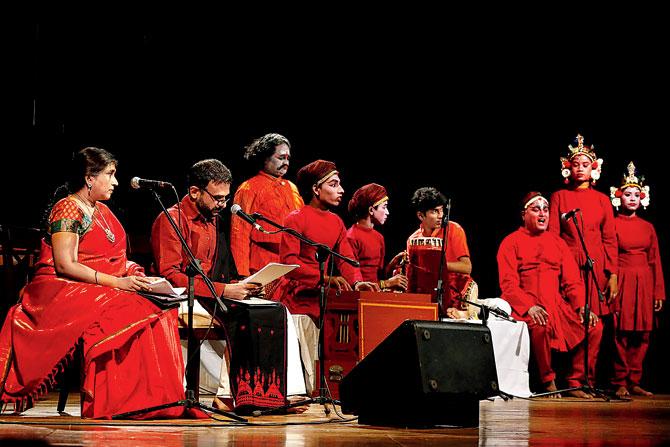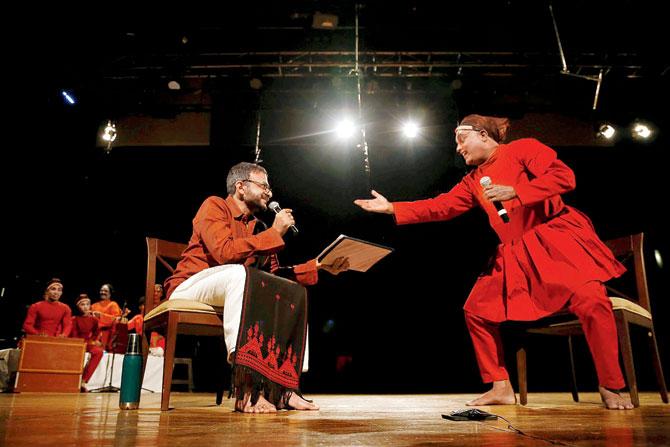Carnatic music and the theatre form of Kattaikkuttu come together in an experimental production that questions the divide between classical and folk

All pictures/Chirodeep Chaudhuri/First Edition Arts
On the spectrum of Indian performing arts, the classical and folk traditions occupy opposite ends. And given our dominant cultural practices, the twain seldom meet. But where there is art and minds open to dialogue, collaborations are a natural corollary - as it was in the case of Carnatic vocalist, writer and social activist TM Krishna and Kattaikkuttu actor, director and playwright P Rajagopal. Both artistes had attended and performed in each other's annual festivals, and sometime in 2015, the idea of doing something together was born.
ADVERTISEMENT
The next year was about the Chennai-based musician couple Krishna and Sangeetha Sivakumar travelling to the Kattaikkuttu Sangam school in Kanchipuram, founded by Rajagopal and his dramaturge wife Hanne M de Bruin, "to explore the contours of each other's aesthetic, social and political worlds," as Krishna puts it.

The performance has been conceptualised by (from left) Sangeetha Sivakumar, TM Krishna. (third from right) P Rajagopal and Hanne M de Bruin. Pic/Chirodeep Chaudhuri/First Edition Arts
The result was Karnatik Kattaikkuttu, a fascinating coalescence of the music tradition and the Tamil language-based, physical and vocal form of rural ensemble theatre. After performing at the Serendipity Arts Festival, Kochi-Muziris Biennale and Ragashankara, Bengaluru, the artistes will be in Mumbai this Saturday to present the open-air theatre performance.
In times of fusion performances, Krishna, however, makes it a point to announce before every show that it precisely isn't one, and that it is a collaboration between two art forms very different from each other. What sets the two apart isn't just the aesthetics though, but the cultural divide of "classical" and "folk". "The problem begins with the construction of the two terms. These need to be discarded," says Krishna.
 Pic/Chirodeep Chaudhuri/First Edition Arts
Pic/Chirodeep Chaudhuri/First Edition Arts
"The divides are multiple and are entrenched in social hierarchies, which include caste, language, urban/rural, etc. They become harder to spot because many times, they express themselves in the form of artistic taste and preference, while they are manifestations of social conditioning. They hence go unchallenged. The arts display the very form of discrimination that we perpetrate in society," adds the vocalist, known for his unconventional approach to music.
Rajagopal agrees. "Naming of forms and whether something counts as art - and for that matter folk or classical - are decided by the arts establishment, not by the performers. Folk performers are outside what we call the public debate; while being vocal, they often lack the vocabulary to analytically discuss their own forms in terms that speak to the establishment," he says, explaining that the performance includes an intermezzo in which he and Krishna speak and sing about these issues.
The two-hour performance is a high-energy visual production depicting dramatic episodes from the Mahabharata. "The disrobing of Draupadi is the pièce de résistance of the Kattaikkuttu repertory, in which I have tried to give more space and a greater voice to Draupadi. This is followed by a sung description of the battlefield by Sangeetha and Krishna and a stylised choreography of the war scenes by the Kattaikkuttu performers. The production concludes with an almost solo-performance of Duryodhana on the last day of the war," informs Rajagopal.
While the distinctiveness of the two art forms is apparent, they share many musical motifs. "This was probably a result of the interaction between the Devadasi and Nadasvara communities that lived in the villages. With the removal of the devadasis from the Carnatic story and the marginalisation of the nadasvara [a shehnai-like instrument] artistes, a chasm was created. Besides, Carnatic music moved away from the villages and became a centralised power modal based out of Madras," explains Krishna. On Sunday, he will also perform with nadasvara artistes for the first time in Aikya: Celebrating the oneness of music.
As an audience member, Devina Dutt of First Edition Arts, the arts company that is taking the performance across India, says watching Karnatik Kattaikkuttu is thrilling. "The two sides genuinely want to speak to each other, without one overwhelming the other," she says. "There is no artistic chauvinism."
ON: January 19, 7 pm (Karnatik Kattaikkuttu).
AT: Chhatrapati Shivaji Maharaj Vastu Sangrahalya, Fort.
RSVP: events@csmvs.in (entry free)
ON: January 20, 7 pm (Aikya).
AT: St Andrew's Auditorium, Bandra West.
ENTRY: Rs 200 onwards
Catch up on all the latest Mumbai news, crime news, current affairs, and also a complete guide on Mumbai from food to things to do and events across the city here. Also download the new mid-day Android and iOS apps to get latest updates
 Subscribe today by clicking the link and stay updated with the latest news!" Click here!
Subscribe today by clicking the link and stay updated with the latest news!" Click here!






